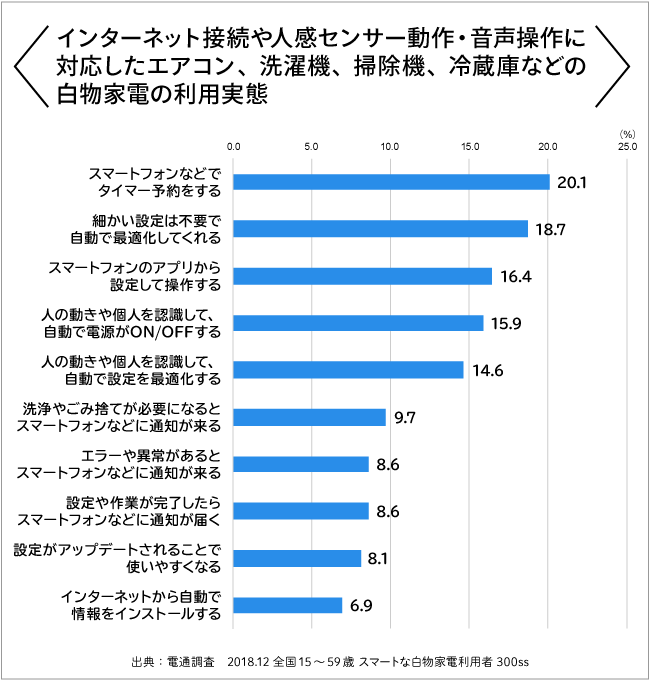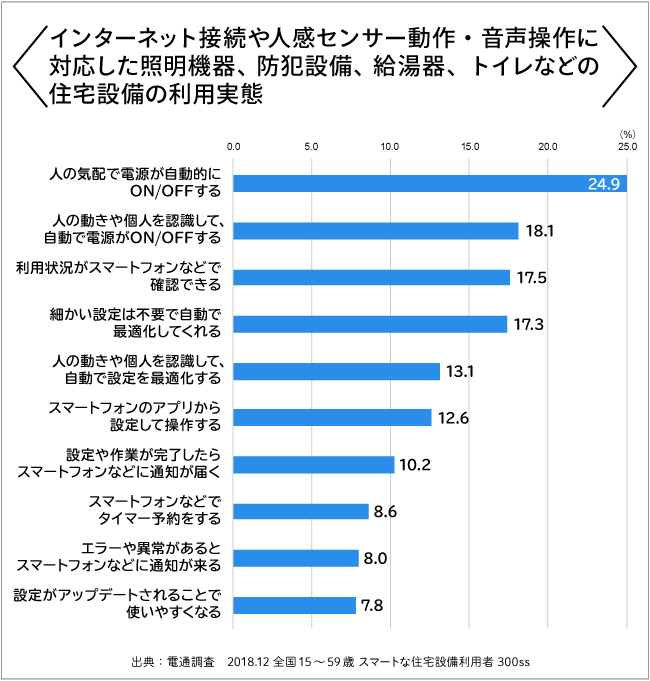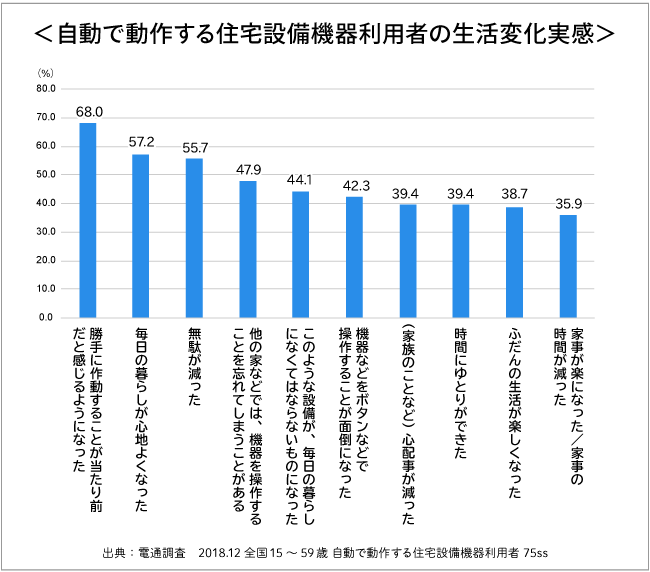The primary functions of smart appliances are "smartphone integration" and "automation."
In recent years, appliances that connect to the internet or integrate with AI speakers have rapidly increased. Integration with smartphones and other devices has also become commonplace in home systems. These are the devices that build what we call the "smart home."
However, the reality is that appliances and home systems have long lifespans, and despite the buzz, they haven't truly permeated everyday life yet. When considering what comes after smartphones, we'll examine the actual usage of internet-connected appliances (like smartphone integration), motion sensor operation, and voice control.
First, we asked respondents whether they owned internet-connected appliances like microwaves (white goods), televisions (black goods), or home equipment like lighting and intercoms, and whether they used voice control or motion sensors.
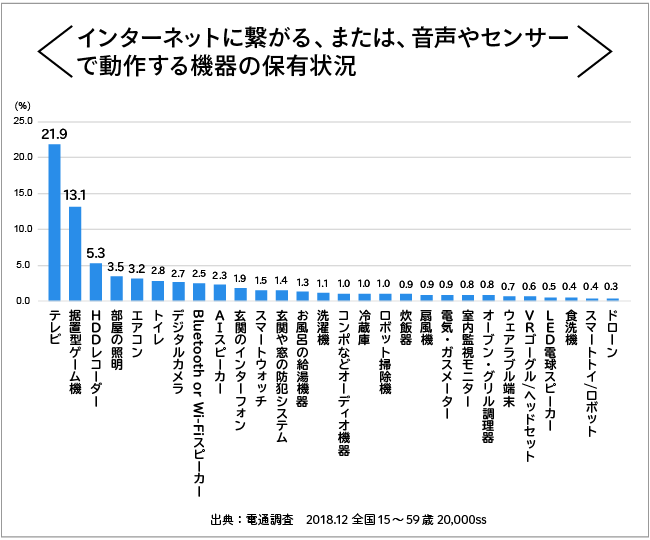
The results showed that even for televisions, the most widely adopted category, usage was just over 20%. Ownership rates for applicable devices were highest for televisions and their peripherals, followed by lighting and air conditioners.
What about usage rates? Usage rates can be lower than ownership rates, and only about 25% of the total population used at least one of these devices. Furthermore, the number of people using specific devices or functions breaks down even further from the total user base, making the volume for each very small.
However, understanding the reality of these advanced users reveals a convenient lifestyle that hints at what comes after smartphones.
Next, we'll examine how these devices are actually being used.
Currently, the functions seeing the most adoption and use are predominantly "smartphone integration" and "automation."
"Smartphone integration" focuses on operation and notifications, while "automation" centers on ON/OFF control and updates/optimization. Let's examine these in more detail.
Smartphone Integration Advances with Black Appliances like TVs and Speakers
The value of "smartphone integration" lies in the ability to set timers remotely and send instructions to devices after completing settings on your phone. The ownership rate of compatible devices is significantly higher for black appliances, and smartphone integration usage is also more advanced compared to white appliances.
Traditionally, setting TV recordings required using the program guide on the TV screen itself, meaning you had to be physically in front of the TV. With smartphone setup, you can schedule recordings while out and about, or even adjust settings during family TV time without interrupting the show everyone is watching.
This isn't a new concept, and many people know it's possible, but the reality is that opportunities to incorporate it into daily life are lacking.
Beyond audio/video equipment, being able to set timers for air conditioners or baths remotely is also a highly practical feature.
Notifications sent to smartphones include robot vacuum cleaners or washing machines completing tasks, updates finishing, or error alerts. You can naturally be notified wherever you are, and it's also possible to set things like having the laundry finish by the time you get home.
For simple completion notifications, the device's own alarm might suffice. However, checking error details or managing timers is more convenient via smartphone.
Personally, I've had to look up error codes and model numbers online multiple times when my washing machine displayed an error. Going forward, I believe smartphones will increasingly serve as the hub, making these checks and interactions with support centers more and more seamless.
Automation advances in home appliances like lighting, toilets, and air conditioners
Now, what about the other aspect of "automation"? This is an area where even greater mainstream adoption is anticipated than smartphone integration. Why? Because it doesn't require a smartphone device, and there's no need to memorize any operations.
If you don't feel uncomfortable with a lifestyle where devices and technology handle things for you, anyone could potentially use it.
There's a term called "universal service," and for many services, operation is necessary, making it crucial to design the UI (user interface) as intuitive as possible.
However, automation inherently requires no operation, meaning UI is fundamentally unnecessary. Design focuses solely on UX (the experience of using the product). Research shows adoption is expanding primarily in home appliances.
The most common type of device that operates automatically without any touch is lighting. Many modern apartments now install motion-sensor lights around entryways, and light bulbs with built-in sensors are also appearing, making lighting the easiest area to introduce automation.
Another common example is the toilet. Many households now have toilets that automatically flush after use.
Air conditioners with motion sensors or temperature sensors are also increasing. These sensors eliminate the need to adjust the temperature via remote control or turn the unit off to regulate the temperature.
While these examples aren't connected to the internet, the areas where automation can be easily introduced are steadily expanding.
Is automation more convenient than smartphone integration? Smartphones become devices for confirmation
When considering future trends, the key focus should be on what value users already see in these smartphone integrations and automations, and how they impact their daily lives.
For those accustomed to smartphone integration, being able to check and control everything via their phone is now second nature. There's no need to move closer to the device. You can operate and check things even when you're out.
Furthermore, as automation becomes widespread and people grow accustomed to not having to operate things manually, they may start to take it for granted that everything will automatically create a comfortable environment for them.
About half of those accustomed to automation report sometimes forgetting to operate devices when visiting others' homes. Forgetting to flush the toilet at someone else's house, for instance, might actually be happening.
Looking further ahead, as more people become accustomed to automation, won't more people start finding it bothersome to operate or configure things via their smartphones?
For example, if the lighting is dim, saying "It's a bit dark" to an AI speaker will make it brighter. It will then continuously sense the brightness and, based on that stored data, adjust settings to optimize the environment without requiring user intervention.
Since the optimization data stock and the AI making judgments reside in the cloud, devices like lighting, which currently achieve automation independently, will likely become standardly connected to the internet in the near future.
With many devices in the home automatically optimizing the environment beyond simple ON/OFF functions, and with cloud services managing them, smartphones—like PCs—are likely to become mere confirmation devices.
Smartphones are undeniably convenient and ubiquitous, making us naturally inclined to connect them. However, automation is the service requiring the least effort. It's undeniable that smartphone integration with home appliances may be a transitional service. Signs of a post-smartphone era are already emerging from the smart home landscape.
[Dentsu Inc. Survey 2018 Overview]
Screening Survey
Survey Period: December 2018
Survey Method: Web-based questionnaire
Respondents: Men and women aged 15-59 nationwide
Sample Size: 20,000 respondents
*Areas and age/gender groups correspond to population distribution ratios
This Survey
Survey Period: December 2018
Survey Method: Web-based questionnaire survey
Survey Participants and Sample Size: 300 respondents each for smart white goods, smart black goods, and smart home equipment users / 75 respondents for users of automatically operated home equipment
※Reflects gender and age distribution of owners identified in the screening survey
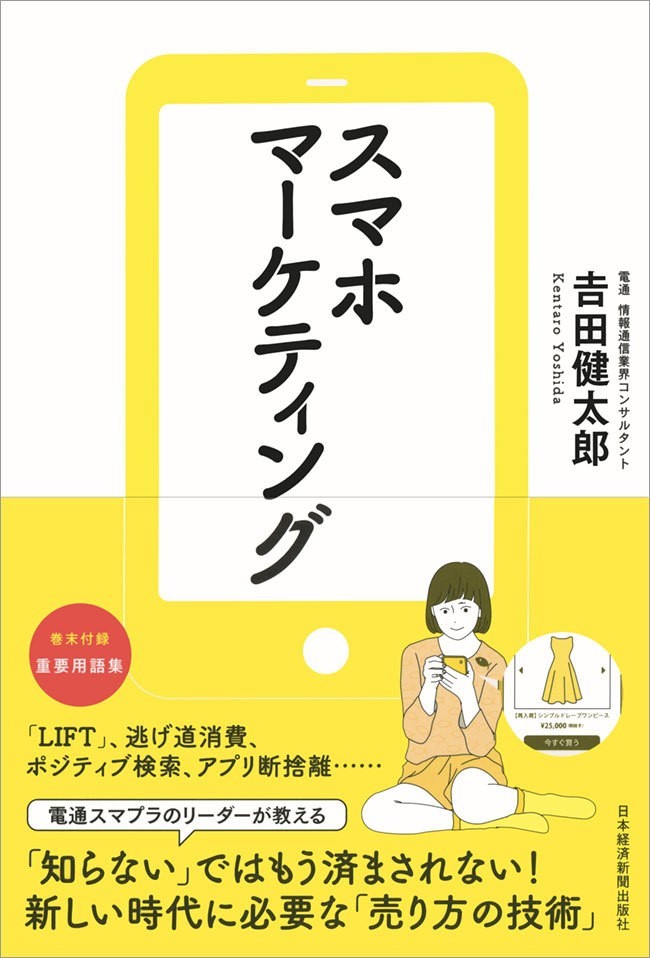
Book now on sale! Details
here.




